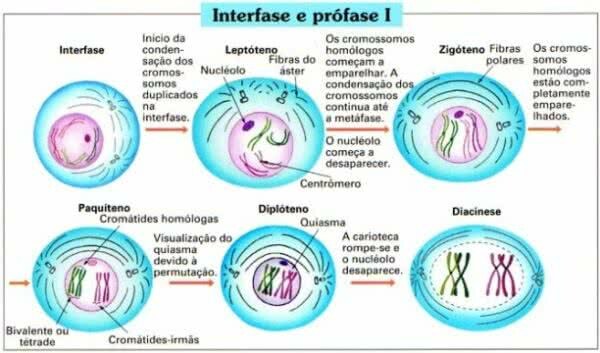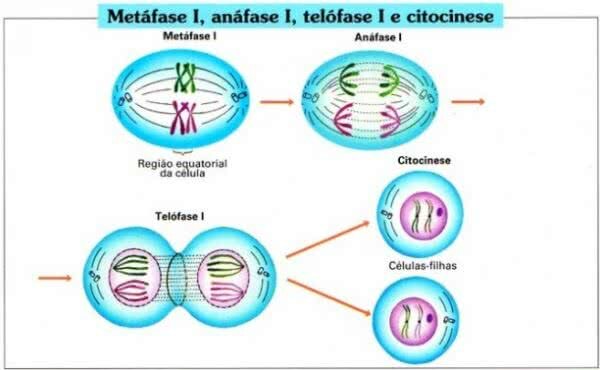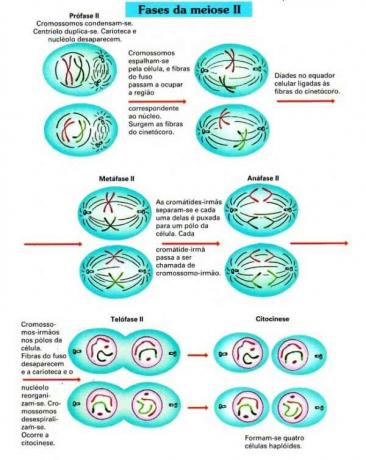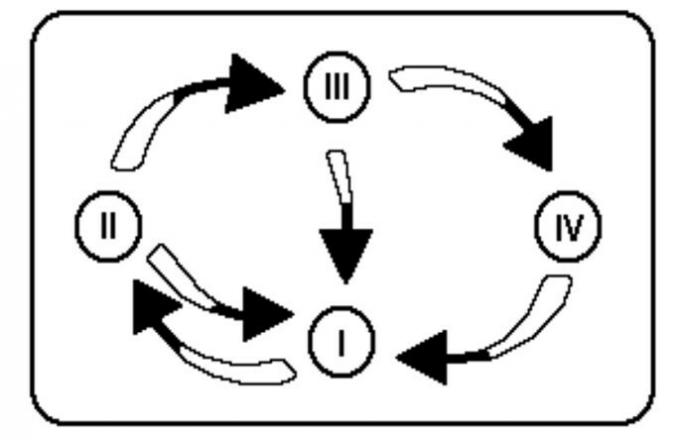Meiosis is the cell division that occurs in the formation of gametes, reducing the number of chromosomes of a species in half.
Thus, a diploid mother cell gives rise to 4 haploid daughter cells.
The process takes place through two steps of successive cell divisions, giving rise to four cells:
- Meiosis I: Reduction step, as the number of chromosomes is reduced by half.
- Meiosis II: Equational step, the number of chromosomes in cells that divide remains the same in cells that form.
Meiosis occurs when the cell enters the stage of reproduction, being the essential process for the formation of gametes, spores and in the divisions of the zygote.
Meiosis phases
Meiosis I
At interphase the chromosomes are thin and long. The duplication of the DNA and of the chromosomes, thus forming the chromatids.
After duplication, the cell division.

Prophase I
Prophase I is a very complex phase, being divided into five consecutive sub-phases:
- Leptothene: each chromosome is formed by two chromatids. You can notice the presence of small condensations, the chromomers.
- Zygotenum: starts the pairing of homologous chromosomes, called synapse, which is completed in the pachytene.
- pachytene: each pair of homologous chromosomes has four chromatids, constituting a bivalent or tetrad, formed by sister chromatids: those that originate from the same chromosome and homologous chromatids: those that originate from chromosomes counterparts. These can break at the same time, and the two pieces can change places, performing a permutation or crossing over. How chromosomes carry genes, there is a gene recombination.
- diplotene: the homologous chromosomes start to drift apart, but remain linked by the regions where the permutation took place. These regions constitute the chiasmas.
- Diakinesis:Condensation and separation of homologous chromosomes continues to occur. As a result, the chiasma slips to the tips of the chromatids, a process called terminationof the chiasmas. As the phases evolve, the nucleolus and the carioteca disappear.

Metaphase I
In metaphase I, the cell membrane disappears. The homologous chromosome pairs organize themselves in the equatorial plane of the cell.
The homologous chromosome centromeres attach to fibers that emerge from centrioles opposites. So each component of the pair will be pulled in opposite directions.
Anaphase I
In anaphase I, there is no division of the centromeres. Each component of the homolog pair migrates towards one of the cell's poles.
Telophase I
In telophase, the chromosomes despiralize, the caryotheca and the nucleolus reorganize and cytokinesis, the division of the cytoplasm, occurs. In this way, two new haploid cells appear.
Meiosis II
Meiosis II is extremely similar to mitosis. The formation of haploid cells from other haploids is only possible because it occurs during meiosis II, the separation of the chromatids that form the dyads.
Each chromatid in a dyad moves to a different pole and can now be called a sister chromosome. The stages of meiosis II are as follows:
Prophase II
Condensation of chromosomes and duplication of centrioles occur. The nucleolus and the caryotheca disappear again.
Metaphase II
The centrioles are ready to be duplicated and the chromosomes organize themselves in the equatorial region.
Anaphase II
The sister chromatids separate and migrate to each pole of the cell, pulled by the spindle fibers.
Telophase II
Spindle fibers disappear and chromosomes are already at the poles of the cell. The caryotheque appears again and the nucleolus reorganizes itself. Finally, cytokinesis occurs and 4 haploid daughter cells appear.

What are the differences between mitosis and meiosis?
THE mitosis and meiosis correspond to the two types of cell division. However, some features differentiate the two processes:
- Mitosis gives rise to two daughter cells identical to the mother cell. Meanwhile, in meiosis, 4 daughter cells with different genetic material than the mother cell are generated. Furthermore, daughter cells still have half the number of chromosomes as the mother cell.
- Meiosis halves the number of chromosomes in the daughter cells. In mitosis the number of chromosomes is kept between the mother cell and the daughter cells.
- Mitosis occurs in most of the body's somatic cells. Meiosis, on the other hand, only occurs in germ cells and spores.
Learn more, read also:
- Mitosis and meiosis: summary of processes, differences and exercises
- Haploid and diploid cells
- Cell
- Cytology
- Cell Core

